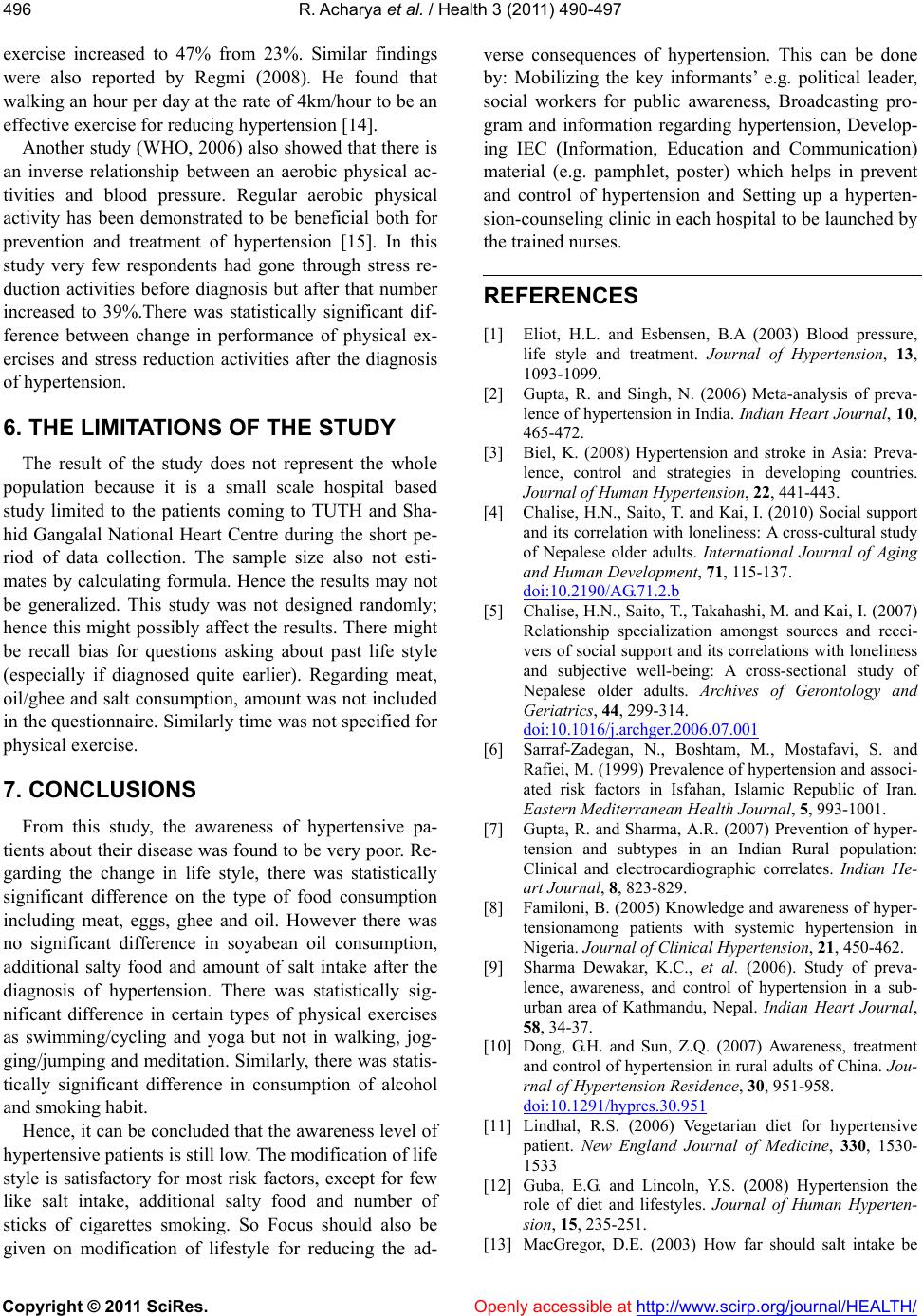
R. Acharya et al. / Health 3 (2011) 490-497
Copyright © 2011 SciRes. Openly accessible at http://www.scirp.org/journal/HEALTH/
496
exercise increased to 47% from 23%. Similar findings
were also reported by Regmi (2008). He found that
walking an hour per day at the rate of 4km/hour to be an
effective exercise for reducing hypertension [14].
Another study (WHO, 200 6) also showed that there is
an inverse relationship between an aerobic physical ac-
tivities and blood pressure. Regular aerobic physical
activity has been demonstrated to be beneficial both for
prevention and treatment of hypertension [15]. In this
study very few respondents had gone through stress re-
duction activities before diagnosis but after that number
increased to 39%.There was statistically significant dif-
ference between change in performance of physical ex-
ercises and stress reduction activities after the diagnosis
of hypertension.
6. THE LIMITATIONS OF THE STUDY
The result of the study does not represent the whole
population because it is a small scale hospital based
study limited to the patients coming to TUTH and Sha-
hid Gangalal National Heart Centre during the short pe-
riod of data collection. The sample size also not esti-
mates by calculating formula. Hence the results may not
be generalized. This study was not designed randomly;
hence this might possibly affect the results. There might
be recall bias for questions asking about past life style
(especially if diagnosed quite earlier). Regarding meat,
oil/ghee and salt consumption, amount was not included
in the questionnaire. Similarly time was not specified for
physical exercise.
7. CONCLUSIONS
From this study, the awareness of hypertensive pa-
tients about their disease wa s found to be very poor. Re-
garding the change in life style, there was statistically
significant difference on the type of food consumption
including meat, eggs, ghee and oil. However there was
no significant difference in soyabean oil consumption,
additional salty food and amount of salt intake after the
diagnosis of hypertension. There was statistically sig-
nificant difference in certain types of physical exercises
as swimming/cycling and yoga but not in walking, jog-
ging/jumping and meditation. Similarly, there was statis-
tically significant difference in consumption of alcohol
and smoking habit.
Hence, it can be concluded that the awareness level of
hypertensive patients is still low. The modification of life
style is satisfactory for most risk factors, except for few
like salt intake, additional salty food and number of
sticks of cigarettes smoking. So Focus should also be
given on modification of lifestyle for reducing the ad-
verse consequences of hypertension. This can be done
by: Mobilizing the key informants’ e.g. political leader,
social workers for public awareness, Broadcasting pro-
gram and information regarding hypertension, Develop-
ing IEC (Information, Education and Communication)
material (e.g. pamphlet, poster) which helps in prevent
and control of hypertension and Setting up a hyperten-
sion-counseling clinic in each hosp ital to be launched by
the trained nurses.
REFERENCES
[1] Eliot, H.L. and Esbensen, B.A (2003) Blood pressure,
life style and treatment. Journal of Hypertension, 13,
1093-1099.
[2] Gupta, R. and Singh, N. (2006) Meta-analysis of preva-
lence of hypertension in India. Indian Heart Journal, 10,
465-472.
[3] Biel, K. (2008) Hypertension and stroke in Asia: Preva-
lence, control and strategies in developing countries.
Journal of Human Hypertension, 22, 441-443.
[4] Chalise, H.N., Saito, T. and Kai, I. (2010) Social support
and its correlation with loneliness: A cross-cultural study
of Nepalese older adults. International Journal of Aging
and Human Development, 71, 115-137.
doi:10.2190/AG.71.2.b
[5] Chalise, H.N., Saito, T., Takahashi, M. and Kai, I. (2007)
Relationship specialization amongst sources and recei-
vers of social support and its correlations with loneliness
and subjective well-being: A cross-sectional study of
Nepalese older adults. Archives of Gerontology and
Geriatrics, 44, 299-314.
doi:10.1016/j.archger.2006.07.001
[6] Sarraf-Zadegan, N., Boshtam, M., Mostafavi, S. and
Rafiei, M. (1999) Prevalence of hypertension and associ-
ated risk factors in Isfahan, Islamic Republic of Iran.
Eastern Mediterranean Health Journal, 5, 993-1001.
[7] Gupta, R. and Sharma, A.R. (2007) Prevention of hyper-
tension and subtypes in an Indian Rural population:
Clinical and electrocardiographic correlates. Indian He-
art Journal, 8, 823-829.
[8] Familoni, B. (2005) Knowledge and awareness of hyper-
tensionamong patients with systemic hypertension in
Nigeria. Journal of Clinical Hypertension, 21, 450-462.
[9] Sharma Dewakar, K.C., et al. (2006). Study of preva-
lence, awareness, and control of hypertension in a sub-
urban area of Kathmandu, Nepal. Indian Heart Journal,
58, 34-37.
[10] Dong, G.H. and Sun, Z.Q. (2007) Awareness, treatment
and control of hypertension in rural adults of China. Jou-
rnal of Hypertension Residence, 30, 951-958.
doi:10.1291/hypres.30.951
[11] Lindhal, R.S. (2006) Vegetarian diet for hypertensive
patient. New England Journal of Medicine, 330, 1530-
1533
[12] Guba, E.G. and Lincoln, Y.S. (2008) Hypertension the
role of diet and lifestyles. Journal of Human Hyperten-
sion, 15, 235-251.
[13] MacGregor, D.E. (2003) How far should salt intake be